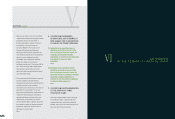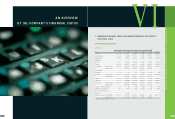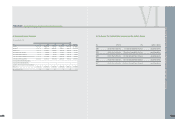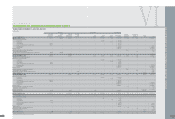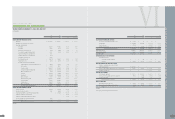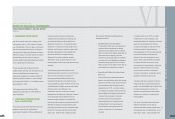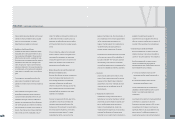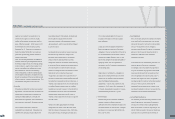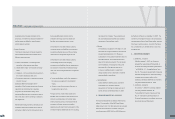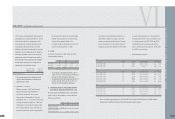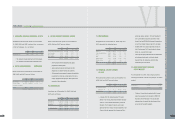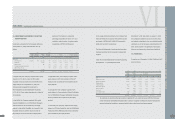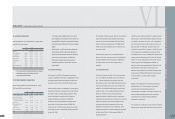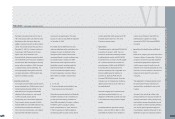HTC 2007 Annual Report Download - page 59
Download and view the complete annual report
Please find page 59 of the 2007 HTC annual report below. You can navigate through the pages in the report by either clicking on the pages listed below, or by using the keyword search tool below to find specific information within the annual report.
113112
AN OVERVIEW OFTHE COMPANY'S FINANCIAL STATUS
balance sheet date, since the nominal value of
the consideration to be received approximates
its fair value and sales transactions are
frequent, the fair value of the consideration is
not determined by discounting all future
receipts using an imputed rate of interest.
An allowance for doubtful accounts is provided
on the basis of a review of the collectibility of
accounts receivable. The Company assesses
the probability of the collection of accounts
receivable by aging analysis and assessing the
value of the collaterals provided by customers.
> Inv
e
n
t
or
i
e
s
Inventories are stated at the lower of cost or
market. Cost is determined using the moving-
average method. Market value is based on
replacement costs of raw materials and work-
in-process and on net realizable values of
finished goods.
>
F
i
n
a
n
c
i
a
l
Ass
e
t
s C
a
rr
i
e
d A
t
Cos
t
Investments in equity instruments with no
quoted prices in an active market and with fair
values that cannot be reliably measured, such
as non-publicly traded stocks and stocks
traded in the emerging stock market, are
measured at their original cost. he accounting
treatment for dividends on financial assets
carried at cost is similar to that for dividends on
available-for-sale financial assets. An
impairment loss is recognized when there is
objective evidence that the asset is impaired. A
reversal of this impairment loss is disallowed.
> Bond Inv
e
s
t
m
e
n
t
s w
i
t
h No A
c
t
i
v
e
M
a
r
k
e
t
Bond investments with no active market are
stated at amortized cost and are classified as
current or noncurrent based on their maturities.
Bond investments with no active market -
current are investments paying fixed or
determinable amounts. Other features of these
bond investments are as follows:
a. The bond investments have not been
designated as at fair value through profit or
loss.
b. The bond investments have not been
designated as available for sale.
Those investments that are noncurrent are
classified as bond investments with no active
market - noncurrent under funds and
investments.
Investments Accounted for by the Equity Method
Investments in companies in which the
Company's ownership interest is 20% or more,
except where the Company cannot exercise
significant influence, are accounted for by the
equity method. The difference between the
investment acquisition cost and the Company's
VI
Taiwan GreTai Securities Market; and financial
assets and financial liabilities without quoted
prices in an active market - at values
determined using valuation techniques.
> Av
a
il
a
b
l
e
-
f
or-S
a
l
e
F
i
n
a
n
c
i
a
l
Ass
e
t
s
Available-for-sale financial assets are initially
measured at fair value plus transaction costs
that are directly attributable to the acquisition.
After the initial recognition, available-for-sale
financial assets are remeasured at fair value at
the balance sheet date, with changes in fair
value recognized in equity until the financial
assets are disposed of. On asset disposal, the
cumulative gain or loss previously recognized
under equity is included in gain or loss for the
year.
The recognition, derecognition and the fair
value bases of available-for-sale financial
assets are similar to those of financial assets at
FVTPL.
Cash dividends are recognized on the
stockholders' declaration under resolutions,
except for dividends distributed from the pre-
acquisition earnings, which are treated as a
reduction of investment cost. Stock dividends
are not recognized as investment income but
are recorded as an increase in the number of
shares. The total number of shares held after
this increase is used to recalculate cost per
share. The difference between the initial cost of
a debt instrument and its maturity amount is
amortized using the effective interest method,
with the amortized interest recognized as gain
or loss.
If there is objective evidence that a financial
asset is impaired, a loss is recognized. If the
impairment loss decreases, the previously
recognized impairment loss is reversed to the
extent of the decrease and recorded as an
adjustment to stockholders' equity.
> R
e
v
e
nu
e
R
e
c
ogn
i
t
i
on, A
cc
oun
t
s R
e
c
e
i
v
a
b
l
e
a
nd
A
ll
ow
a
n
c
e
f
or Doub
tf
u
l
A
cc
oun
t
s
Revenue from the sale of goods is recognized
when the Company has transferred to the
buyer the significant risks and rewards of
ownership of the goods, primarily upon
shipment, because the earnings process has
been completed and the economic benefits
associated with the transaction have been
realized or are realizable.
Revenue is measured at the fair value of the
consideration received or receivable and
represents amounts agreed between the
Company and the customers for goods sold in
the normal course of business, net of sales
discounts and volume rebates. For trade
receivables due within one year from the
FINANCEI INDEPENDENT AUDITORS' REPORT
l


